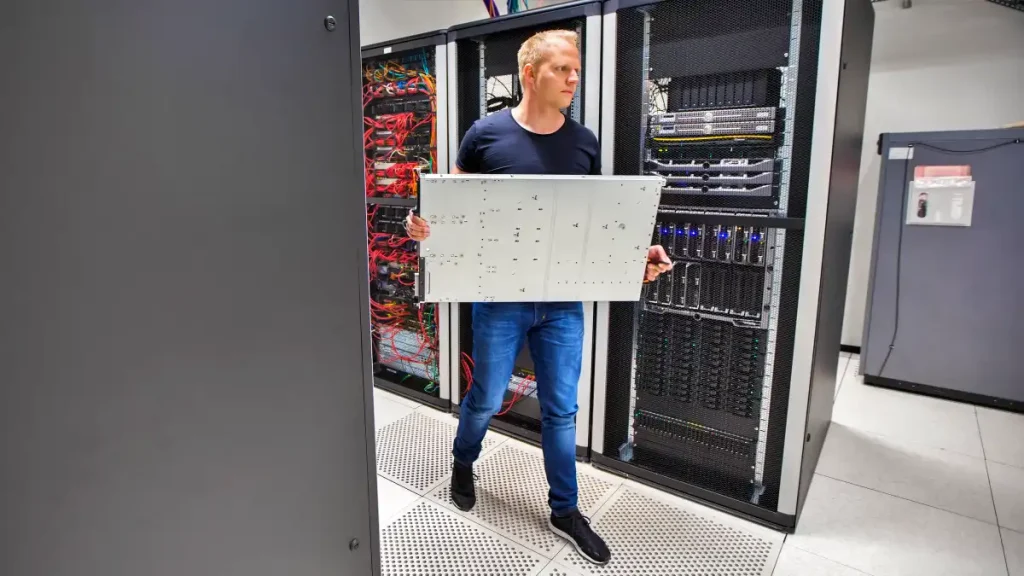As businesses increasingly embrace digital transformation, the demand for scalable data centers has never been more critical. Scalability is not merely a buzzword – it’s the cornerstone of future-ready infrastructure. The ability to swiftly adapt and expand resources in response to shifting operational needs can define an organization’s success or failure. According to IDC’s research, the global data sphere is predicted to grow exponentially, reaching 175 zettabytes by 2025. Understanding how to build and manage scalable data centers is paramount for IT managers, facility planners, and business executives alike.

The shift towards digital solutions has fundamentally altered data processing and storage capabilities expectations. Today’s enterprises require robust infrastructures that can handle unpredictable spikes in workload driven by emerging technologies such as IoT, artificial intelligence, and big data analytics. As these demands intensify, traditional data center architectures often fall short, leading organizations to seek innovative approaches to scaling their operations effectively. In this article, we will explore essential considerations for creating a future-ready infrastructure that not only meets current demands but is also flexible enough to accommodate unforeseen changes on the horizon.
The Need for Scalable Infrastructure
As businesses evolve in today’s digital economy, the demand for scalable infrastructure becomes increasingly essential. Companies often face changing operational pressures stemming from market shifts, customer demands, and technological advancements. For instance, during the COVID-19 pandemic, many organizations experienced a surge in online activity, prompting sudden adaptations across their IT landscape. In such scenarios, the capability to scale up resources swiftly is imperative to maintain service continuity and meet consumer expectations. Without a scalable data center framework that supports rapid adjustment, organizations risk falling behind competitors who have already established agile infrastructures.
Furthermore, scalability is about future-proofing against unpredictable growth trends. The rise of technologies like artificial intelligence (AI) and big data analytics requires ample computing power and efficient data management capabilities. A retail company anticipating higher traffic due to an online sales campaign must ensure its infrastructure can accommodate increased workloads without compromising performance. If the underlying systems are rigid, they may lead to crippling downtime or degraded user experiences at crucial moments, jeopardizing both revenue and reputation. Therefore, integrating a flexible architecture enables firms to pivot rapidly in response to unanticipated market dynamics or consumer behavior changes.
In addition to reactionary scaling prompted by transformative events, proactive planning plays a vital role in defining scalability requirements. Businesses that regularly assess projected growth trajectories are better equipped to adapt their infrastructures seamlessly over time. By investing in cloud solutions or hybrid models that leverage both on-premise assets and off-site services, organizations can create an adaptable environment ready for unforeseen technological advancements or marketplace shifts. Such foresight facilitates ongoing success and significantly reduces capital expenditures by ensuring investments align with real business objectives rather than speculative initiatives.
Ultimately, as companies navigate an era laden with digital transformation imperatives and diverse technology options, understanding scalability’s critical impact on operations stands paramount. Ensuring your infrastructure can flexibly respond to both immediate demands and long-term aspirations will position your organization favorably against competitors—allowing it to thrive today while preparing for tomorrow’s uncertainties.
Key Considerations for Planning Scalability
When planning for a scalable data center, beginning with an in-depth assessment of current and anticipated workloads is crucial. Understanding the existing demands on your infrastructure allows IT managers and business executives to identify potential bottlenecks and areas requiring adjustment. For example, a tech startup focusing on software development may project increased user demand as its application gains popularity. Anticipating this shift can enable data center operators to allocate resources efficiently, ensuring performance remains consistent under high-traffic scenarios. Organizations should regularly revise their workload assessments since evolving customer requirements can necessitate rapid adaptations.
Alongside analyzing workloads, evaluating technology options that support flexibility is critical when considering scalability. Today’s landscape offers a multitude of solutions designed to seamlessly integrate with existing systems while providing additional capacity as needed. Technologies such as hyper-converged infrastructure (HCI) illustrate this point well; HCI combines computing, storage, and networking into a single framework that simplifies expansion without necessitating significant alterations in architecture. A pertinent illustration can be found in how large enterprises like Netflix strategically adopted cloud services while employing HCI to manage intense streaming demands during peak seasons, successfully scaling their capabilities without sacrificing service quality.
Moreover, organizations must also consider investing in robust resource management tools that facilitate monitoring of both current utilization rates and future growth projections. These tools provide valuable data insights that drive informed decision-making regarding investments in infrastructure upgrades or expansions. The integration of machine learning algorithms into these platforms enhances their effectiveness by predicting workload spikes based on past trends, allowing businesses to proactively manage scaling processes rather than waiting until issues arise.
In summary, effective scalability planning hinges on critically assessing present workloads while remaining vigilant about future changes and technology advancements that support flexibility. By committing to continuous evaluation and adopting the right technologies, IT managers can equip their organizations to swiftly respond to emerging challenges in the digital landscape—ultimately ensuring seamless operations now and into the future.
Modular Design: A Blueprint for Growth
Modular architecture has emerged as a revolutionary approach in the design of scalable data centers, offering numerous advantages over traditional layouts. Organizations can significantly enhance their capacity to expand or reconfigure their infrastructure by adopting a modular design. This flexibility allows businesses to respond swiftly to changing demands and emerging technologies without the need for disruptive renovations or costly overhauls. Modular designs facilitate quicker deployment of additional resources, which can be crucial during peak periods or when faced with unexpected growth pressures.
One notable benefit of modular design is its efficiency in resource management. Modularity enables data centers to implement smaller, self-contained units that can operate independently but also integrate seamlessly with one another. For example, Google has successfully utilized modular systems in their facilities to achieve remarkable energy efficiency and cost-effectiveness. Their pre-fabricated modules allow them to rapidly scale up operations while maintaining optimal performance levels across diverse geographic locations. This case exemplifies how modular designs can deliver immediate scalability and long-term operational benefits.
Another compelling example is Facebook’s data center in Altoona, Iowa, which features a highly automated and modular layout built for rapid expansion. The facility was designed with containerized servers that facilitate swift scaling according to demand fluctuations without extensive construction delays. Implementing this modular strategy allowed Facebook to increase efficiency significantly while reducing costs associated with floor space and power consumption. Similar success stories highlight the growing trend toward implementing these strategies among leading technology firms.
Ultimately, leveraging modular design principles within data center architecture represents a forward-thinking approach that accommodates future growth while minimizing inefficiencies inherent in traditional builds. As more organizations look toward creating adaptable infrastructures capable of supporting evolving technological landscapes, the adoption of modular solutions will likely become increasingly prevalent—a blueprint for success in ensuring sustainable scalability amidst constant change.
Flexible Contracts for Dynamic Needs
As businesses navigate the unpredictable landscape of modern technology, the need for flexibility in contract structures becomes paramount. Traditional fixed-term contracts can stifle growth and limit a data center’s ability to adapt swiftly to changes in demand. By exploring alternative contracting models—such as pay-as-you-go, subscription-based, or performance-based agreements—organizations can align their operational costs with actual usage, allowing for increased agility during times of expansion or contraction. This adaptability enhances financial management and fosters innovation by freeing up capital that can be reinvested into strategic initiatives.
Collaboration with vendors plays a crucial role in developing contracts that support scalable infrastructure. Open communication regarding anticipated growth and specific needs should form the foundation of these partnerships. For instance, some companies have successfully negotiated terms that include scalability clauses, wherein additional capacity can be added without incurring exorbitant penalties or fees. This approach reduces friction during scaling processes and ensures that service providers are fully aware of the customer’s evolving requirements. As evidenced by tech giants like Amazon Web Services (AWS), having contract structures that reflect a partnership mentality can lead to mutual benefits; while AWS provides robust scalability options, businesses using their services benefit from seamless operations aligned with their growth trajectory.
Moreover, incorporating periodic reviews within contracts allows organizations to adjust terms based on real-time performance metrics and forecasting insights. Establishing these checkpoints creates opportunities for renegotiation based on observed usage patterns and changing business strategies. Instead of waiting until contract renewal periods to address misalignments between service capabilities and business needs, such innovative approaches empower enterprises to make timely adjustments that ensure alignment with future objectives.
In essence, crafting flexible contracts is essential to building a future-ready data center infrastructure. The right contractual relationships facilitate adaptability and resilience amid evolving market demands while promoting proactive engagement with providers who understand and support an organization’s goals. Businesses must view vendors as suppliers and allies in enabling success through scalable solutions tailored to dynamic realities.
Efficient Resource Management Strategies
In the fast-evolving landscape of data centers, efficient resource management is essential for maintaining operational effectiveness and meeting fluctuating demands. As businesses increasingly rely on data-driven decision-making, IT managers must optimize resource allocation continuously. This means assessing current system utilization to identify underused resources while ensuring appropriate contingencies for unanticipated demand surges. For example, a retail company may experience a spike in traffic during holiday seasons or promotional events; thus, having a flexible and dynamic resource management strategy is crucial to handle such variations without compromising performance.
One effective technique involves implementing just-in-time resource provisioning, which allows organizations to allocate computing power based on real-time needs. Utilizing cloud platforms enables this flexibility by allowing companies to scale up or down their resources as required easily. For instance, Netflix leverages cloud services where it can automatically adjust capacity depending on viewer demand at any given moment. By adopting similar strategies, other enterprises can effectively manage costs while still delivering high-quality services during peak periods.
Automation plays a pivotal role in enhancing operational efficiency within scalable data centers. Automated systems can monitor workloads and environmental conditions 24/7, enabling swift adjustments that manual systems can’t achieve. For instance, utilizing machine learning algorithms within existing infrastructure can predict when specific resources will be under strain based on historical data patterns. Companies like Google have successfully implemented automation tools in their data centers to optimize cooling systems dynamically—saving energy while improving performance simultaneously. These proactive measures enhance overall efficiency and contribute to sustainability efforts by reducing unnecessary power consumption.
The integration of automated solutions allows IT teams to focus more on strategic projects rather than routine management tasks, thereby driving innovation across the organization. By establishing a culture that values efficient resource management through automation and proactive planning, businesses can create an agile infrastructure capable of keeping pace with emerging technological advancements and ever-changing market demands. In doing so, they not only future-proof their operations but also position themselves favorably against competitors who might struggle with rigid infrastructures lacking such adaptability.
Security and Compliance in Scalable Designs
Security concerns become increasingly pronounced as organizations scale their data centers to meet growing demands. Rapid scaling often introduces numerous vulnerabilities, making implementing robust security strategies that can adapt alongside infrastructural changes imperative. For instance, the expansion of network endpoints during rapid growth could provide more opportunities for cyberattacks if not adequately protected. To mitigate these risks, businesses should develop a comprehensive security framework that encompasses both physical and digital protections. This includes deploying advanced intrusion detection systems and regular vulnerability assessments to identify weak points in a continuously evolving architecture.
Compliance is another crucial aspect that cannot be overlooked in scalable designs. As businesses expand their operations, they may enter new markets or jurisdictions with varying regulatory requirements. Consequently, IT managers must ensure that their infrastructure meets pertinent compliance standards—such as GDPR for handling personal data or HIPAA in healthcare environments—at all times. Failing to comply can result in severe penalties and reputational damage. A practical approach includes embedding compliance checks into every layer of the data center’s architecture from the outset. Regular audits and leveraging automated compliance tools can help ensure ongoing adherence while allowing organizations the agility needed to respond promptly to regulatory changes.
Moreover, integrating security measures into scalable designs encourages proactive risk management rather than reactive patchwork solutions. For example, adopting a zero-trust model ensures that every user and device accessing the system is authenticated and authorized before gaining access to resources. This model aligns with modern scalability by maintaining strict access controls regardless of how quickly an organization expands its capabilities or cloud services. Furthermore, extensively utilizing encryption—both at rest and in transit—can significantly enhance data protection across various infrastructure layers.
Future Technologies Impacting Data Center Scalability
As businesses increasingly adopt digital transformation strategies, emerging technologies play a pivotal role in enhancing data center scalability. One notable trend is edge computing, which shifts data processing closer to the source of information generation, such as IoT devices and local servers. This development alleviates latency issues that can hinder application performance and enables businesses to use real-time analytics. For instance, a retail chain leveraging edge computing can analyze customer behavior in-store instantaneously, optimizing inventory management based on real-time demand. By integrating edge computing into their infrastructure planning, organizations can create highly responsive IT environments to handle unanticipated data traffic spikes.
Additionally, artificial intelligence (AI) and machine learning advancements offer powerful tools for designing future-ready infrastructures. AI-driven analytics can optimize resource allocation by predicting workload patterns and identifying underutilized assets—enabling more efficient use of existing resources while facilitating seamless scalability. For example, cloud service providers are utilizing AI algorithms to allocate additional server capacity automatically when surge demand is detected, thus ensuring continued performance without manual intervention. These intelligent systems reduce operational costs and enhance overall reliability by mitigating failures before they occur.
The incorporation of AI and edge computing alongside traditional cloud solutions illustrates a growing trend toward hybrid architectures—where scalable resources blend decentralized and centralized capabilities. Organizations must anticipate how these technologies will evolve and interact within their current infrastructure to capitalize on opportunities that drive growth efficiently. As enterprises prepare for the onset of 5G technology and an ever-expanding array of connected devices, having a forward-thinking strategy becomes imperative for maintaining competitive advantage amidst rapid technological changes.
Measuring Success: KPIs for Scalable Data Centers
To ensure that a data center can effectively scale to meet growing demands, it is crucial to establish clear key performance indicators (KPIs) that directly relate to scalability. These metrics act as guiding frameworks, helping IT managers and facility planners assess whether their infrastructure can adapt to future challenges. Commonly used KPIs include:
- Resource utilization rates;
- Response times for scaling requests;
- System downtime during peak loads.
Data center operators can consistently monitor these indicators to identify inefficiencies and areas requiring immediate attention.
For instance, resource utilization rates should be analyzed in terms of overall consumption and the ability to rapidly provision additional capacity when needed. A data center running at 70% capacity may seem efficient; however, if it cannot handle spikes in demand without significant latency or downtime, then its scalability remains questionable. Utilizing real-time analytics tools enables teams to visualize trends over time and anticipate future needs before they become critical issues.
Additionally, response times associated with scaling requests provide a window into how well your systems accommodate rapid growth or changes in workload availability. A successful scalable infrastructure should boast minimal delays when provisioning resources—any appreciable lag signals potential bottlenecks that need addressing. Regularly analyzing these response times, along with tracking customer satisfaction, will highlight where adjustments are necessary.
Finally, measuring system downtime during periods of peak load acts as an important litmus test for scalability effectiveness. High levels of downtime impact revenue and could lead to eroded trust among clients or users relying on consistent service delivery. By correlating this metric with scheduled versus unscheduled scaling actions taken in anticipation of traffic peaks, organizations can derive insights leading to enhanced contingency planning and improved resilience in their data centers moving forward. Establishing robust KPI frameworks paves the way for continuous optimization of operations—essential for any organization aiming for sustainable growth in a digitally-driven landscape.
Embracing Scalability for a Future-Ready Infrastructure
The necessity of proactive planning in data center scalability cannot be overstated. As businesses navigate an increasingly digital landscape, they must anticipate future demands and technological advancements that can impact their infrastructure. By embracing modular designs, flexible contracting, and efficient resource management strategies, organizations can create robust frameworks that adapt to both current needs and unforeseen challenges. The insights shared throughout this article highlight how scalable solutions foster operational efficiency and enhance overall performance.
Moreover, continuous reassessment of your infrastructure is vital for staying aligned with emerging industry trends and business innovations. Regularly evaluating key performance indicators will empower IT managers and data center operators to make informed decisions regarding capacity upgrades or technology investments. Ultimately, building a future-ready infrastructure requires thoughtful design and an ongoing commitment to adapting as market conditions evolve—ensuring your organization remains competitive in a rapidly changing world.







